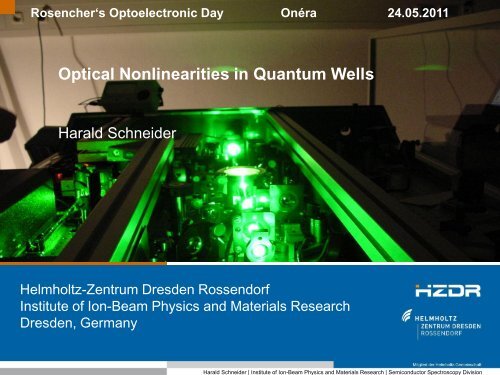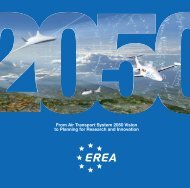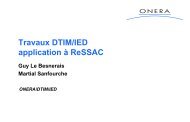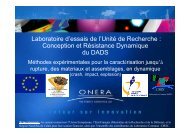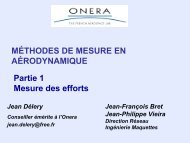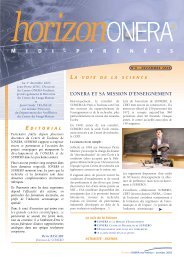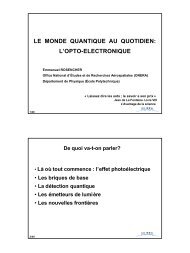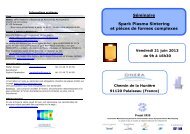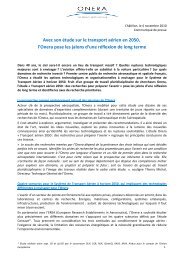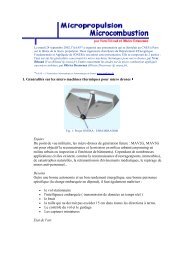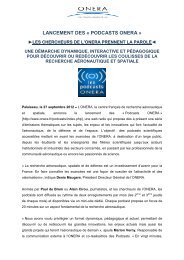E - Onera
E - Onera
E - Onera
You also want an ePaper? Increase the reach of your titles
YUMPU automatically turns print PDFs into web optimized ePapers that Google loves.
Harald Schneider | Institute of Ion-Beam Physics and Materials Research | Semiconductor Spectroscopy Division<br />
Rosencher‘s Optoelectronic Day Onéra 24.05.2011<br />
Optical Nonlinearities in Quantum Wells<br />
Harald Schneider<br />
Helmholtz-Zentrum Dresden Rossendorf<br />
Institute of Ion-Beam Physics and Materials Research<br />
Dresden, Germany
Outline<br />
Introduction<br />
Optical Rectification<br />
Harmonic Generation & Two-Photon Absorption<br />
Difference-Frequency Generation<br />
Conclusion<br />
2
Optical nonlinearities in QW: Classification<br />
Our focus today:<br />
Resonant intersubband (intraband) nonlinearities<br />
Not covered (but also interesting):<br />
Interband optical nonlinearities<br />
CB<br />
e2<br />
e1<br />
• Electro-optical effects<br />
e.g., quantum-confined Stark effect<br />
intensity and phase modulators<br />
• Excitonic nonlinearities<br />
Marginally covered:<br />
Mixed interband/intersubband nonlinearities<br />
hh1<br />
lh1<br />
hh2<br />
lh2<br />
VB<br />
3
Optical nonlinearities involving intersubband transitions<br />
Second-order<br />
Optical rectification E. Rosencher et al., APL 55 1597 (1989)<br />
Second-harmonic generation M.M. Fejer et al., PRL 62, 1041 (1989)<br />
Difference-frequency mixing C. Sirtori et al., APL 65, 445 (1994)<br />
Sum-frequency mixing H.C. Liu et al., IEEE JQE 31, 1659 (1995)<br />
Third-order<br />
Four-wave mixing D. Warlod et al., APL 59, 2932 (1991)<br />
Third-harmonic generation C. Sirtori et al., PRL 68, 1010 (1992)<br />
Dc Kerr effect A. Sa’ar et al., APL 61, 1263 (1992)<br />
Two-photon absorption E. Dupont et al., APL 65, 1560 (1994)<br />
4
ITQW Conference<br />
1991 Cargèse<br />
2011 Badesi<br />
5
… often used for nonlinear<br />
wavelength conversion<br />
integrated with quantum<br />
cascade lasers<br />
7<br />
Nature 391, 464 (1998)
Outline<br />
Introduction<br />
Optical Rectification<br />
Harmonic Generation & Two-Photon Absorption<br />
Difference-Frequency Generation<br />
Conclusion<br />
8
Nonlinear susceptibility<br />
<br />
(2)<br />
0,max<br />
<br />
q T<br />
2<br />
3 2<br />
2<br />
2<br />
0<br />
2<br />
N1<br />
N2<br />
1212<br />
T 2 dephasing time<br />
12 |<br />
1| z<br />
| 2 |<br />
12 2 | z | 2 1| z<br />
|1<br />
More than 10 3 higher nonlinearity than in bulk GaAs<br />
Additional contribution due to T 1 , which is ~10x longer than T 2 !<br />
9
Sainte Chapelle, Paris<br />
Little devil who holds the electron<br />
at its place, thus preventing it from<br />
returning back to the ground state<br />
10
Semiclassical<br />
"rectification efficiency"<br />
<br />
(2)<br />
0,max<br />
<br />
3<br />
q T2<br />
<br />
2<br />
2<br />
<br />
0<br />
T 2 dephasing time<br />
storage time<br />
2<br />
N1<br />
N2<br />
1212<br />
<br />
More than 10 6 higher efficiency than in GaAs!<br />
11
12<br />
Several periods with thick inter-well barriers
From rectification to detection …<br />
Thin inter-period barriers<br />
dc photocurrent!<br />
13
Optimization<br />
high absorption strength<br />
high escape probability<br />
high capture probability<br />
small tunneling probability<br />
Low-noise QWIP<br />
1: excitation zone<br />
2: drift zone<br />
3: capture zone<br />
4: tunnel barrier zone<br />
no tunneling<br />
no thermal re-emission<br />
high tunneling probability<br />
14
ENERGY (meV)<br />
Parameters and subbands<br />
20 periods<br />
4.8 nm GaAs:Si<br />
45.0 nm AlGaAs x=0.26<br />
4x10 11<br />
1<br />
cm -2 excitation<br />
zone<br />
2<br />
drift zone<br />
1.8 nm GaAs 3<br />
1.8 nm AlGaAs x=0.26 capture<br />
3.0 nm GaAs zone<br />
0.6 nm AlAs 4<br />
1.8 nm AlGaAs x=0.26 tunnel<br />
0.6 nm AlAs barrier<br />
3.6 nm AlGaAs x=0.26 zone<br />
250<br />
200<br />
150<br />
100<br />
50<br />
1<br />
2<br />
3<br />
4<br />
0<br />
0 20 40 60 80 100 120<br />
POSITION (nm)<br />
15<br />
Appl. Phys. Lett. 71, 2646 (1997)
CURRENT (A)<br />
Response at 300 K background temperature<br />
• Photovoltage due to<br />
thermal background<br />
radiation<br />
10 -8<br />
cold shield<br />
T B<br />
=300 K, 45° facet<br />
T B<br />
=300 K, grating<br />
(expected)<br />
10 -7 120x120 µm 2<br />
• Background limited<br />
performance<br />
10 -9<br />
10 -10<br />
65 K<br />
-4 -3 -2 -1 0 1<br />
BIAS VOLTAGE (V)<br />
16
DETECTIVITY (cmHz 1/2 /W)<br />
“Low-Noise” QWIP<br />
• same D * as for conventional QWIPs<br />
• both polarities demonstrated<br />
other polarity<br />
• carrier density<br />
PC QWIP 8 x 10 10 cm -2<br />
“Low-Noise” 4 x 10 11 cm -2<br />
Photoconductive QWIP<br />
" Low-Noise" QWIP in PC mode<br />
fit to all data<br />
10 10 77 K<br />
45° facet geometry<br />
20 periods<br />
8.6 8.7 8.8 8.9 9.0 9.1 9.2 9.3 9.4 9.5<br />
LONG WAVELENGTH CUTOFF (µm)<br />
Physica E 7, 101 (2000)<br />
17
640 x 512 “Low-Noise” QWIP FPA<br />
NETD = 9.6 mK<br />
7.4 - 9.2 µm<br />
f/2, 30 ms, 60 K<br />
18<br />
H. Schneider and H. C. Liu, Quantum Well Infrared Photodetectors, Springer 2007<br />
AIM
Outline<br />
Introduction<br />
Optical Rectification<br />
Harmonic Generation & Two-Photon Absorption<br />
Difference-Frequency Generation<br />
Conclusion<br />
19
Nonlinear susceptibility for SHG<br />
N1<br />
N2<br />
1223<br />
31<br />
(2) 2<br />
2 ,max<br />
~ T2<br />
<br />
Dipole moments<br />
µ 12 , µ 23 , µ 31 0<br />
Need asymmetry<br />
SHG in step QWs<br />
Up to 3 orders of magnitude more efficient than in bulk GaAs<br />
20
High-efficiency SHG<br />
conversion possible<br />
provided that we can beat<br />
the losses…<br />
21
Nonlinear susceptibility<br />
(2)<br />
3 ,max<br />
~ NT12T23T3412233441<br />
µ 12 , µ 23 , µ 34 µ 41 0<br />
T 12 , T 23 , T 34 dephasing times<br />
22
Intracavity SHG and THG in quantum cascade lasers<br />
23<br />
T. Moseley et al., Opt. Express 12, 2972 (2004)<br />
C. Gmachl et al., IEEE JQE 39, 1345 (2003)
50 µW<br />
80 K<br />
298 K<br />
6 µW<br />
Efficiency 0.13 mW/W 2 (RT), 0.04 mW/W 2 (80K), 19 mW/W 2 (theory)<br />
Deviation due to higher lateral modes, detuning from resonance, …<br />
24
Two-photon absorption<br />
TPA coefficient<br />
<br />
~<br />
, max<br />
N<br />
D<br />
2<br />
12<br />
23T2<br />
12<br />
<br />
( 3)<br />
<br />
T 2 dephasing time 21<br />
T e dephasing time associated with state 3<br />
Independent of µ 31 (in contrast to SHG)<br />
TPA works with a symmetric QW structure!<br />
T<br />
e<br />
E 2<br />
E 3<br />
E 1<br />
E 3<br />
Semiclassical (analogy with opt. rectification)<br />
"Sequential TPA"<br />
<br />
N<br />
D<br />
2step,max<br />
~ 12234<br />
12<br />
T 1 lifetime for 21<br />
T<br />
1<br />
T<br />
2<br />
T<br />
e<br />
E 2<br />
E 1<br />
25
QWIPs with quadratic power dependence<br />
Resonant two-photon QWIP<br />
3<br />
2<br />
1<br />
E 3 - E 2 = E 2 - E 1<br />
Standard QWIP<br />
2<br />
1<br />
• Photocurrent (power) ²<br />
stronger signal if two pulses overlap in time<br />
• photocurrent<br />
power density<br />
26
norm. Photocurrent<br />
Time Resolution of Two-Photon-QWIP<br />
Autocorrelation measurements<br />
using 170 fs mid-IR pulses<br />
• 8:1 peak-to-background-ratio<br />
nearly ideal autocorrelation<br />
for small delay times<br />
8<br />
6<br />
4<br />
2<br />
= 10.4µm<br />
Bias = 1V<br />
T = 77K<br />
Sub-ps time resolution<br />
Influence of intermediate state<br />
on detector response<br />
• Oscillations decrease exponentially<br />
phase relaxation T 2<br />
• Exponential behavior of the "wings“<br />
intersubband relaxation T 1<br />
0<br />
8<br />
6<br />
4<br />
2<br />
0<br />
-1 0 1<br />
Delay Time (ps)<br />
ideal autocorrelation<br />
of 165 fs pulse<br />
IR Phys. Technol. 47, 182 (2005)<br />
27
Photocurrent (a. u.)<br />
Photocurrent (a. u.)<br />
Determining T 1 and T 2 by numerical fits<br />
8<br />
6<br />
well doped<br />
experimental<br />
numerical fit<br />
8<br />
6<br />
modulation doped<br />
experiment<br />
numerical fit<br />
4<br />
2<br />
= 10.4 µm<br />
Bias = 1 V<br />
T = 77 K<br />
4<br />
2<br />
=10.6µm<br />
Bias = 0.2 V<br />
T=70K<br />
0<br />
0.0 0.2 0.4 0.6 0.8 1.0 1.2<br />
Delay Time (ps)<br />
well doped<br />
mod.<br />
doped<br />
T 1 530 fs 750 fs<br />
T 2 120 fs 240 fs<br />
0<br />
0.0 0.2 0.4 0.6 0.8 1.0 1.2<br />
Delay Time (ps)<br />
28<br />
Appl. Phys. Lett. 91, 191116 (2007)
Signal (arb. units)<br />
Signal (arb. units)<br />
Quadratic Autocorrelation at Room Temperature<br />
6<br />
4<br />
interferometric<br />
intensity<br />
autocorrelation<br />
300 K<br />
InGaAs/AlGaAs<br />
6.2 nm QW<br />
= 5.4 µm<br />
6<br />
4<br />
EXP<br />
FIT<br />
2<br />
2<br />
0<br />
0<br />
-4 -2 0 2 4 -0.02 0.00 0.02 0.04 0.06<br />
Time (ps)<br />
Time (ps)<br />
Interferometric autocorrelation 6:1 (ideally 8:1)<br />
Intensity autocorrelation 2.2:1 (ideally 3:1)<br />
Fringes<br />
(1-cos) 2 shape<br />
FWHM 3.7 ps<br />
FEL pulse width 2.6 ps<br />
29<br />
H. Schneider et al., Appl. Phys. Lett. 93, 101114 (2008)
Photocurrent (arb. u.)<br />
THz Two-Photon QWIP<br />
8<br />
6<br />
4<br />
2<br />
Interferometric autocorrelation<br />
Intensity autocorrelation<br />
= 42 µm<br />
9.5 K, 0.5 V<br />
18 nm GaAs/AlGaAs QWs<br />
6<br />
4<br />
2<br />
0<br />
-0.4 0.0 0.4<br />
0<br />
-10 -5 0 5 10<br />
Time Delay (ps)<br />
Operation below the Reststrahlenband at 42 µm (7 THz)<br />
FWHM 6.2 ps 4.4 ps FEL pulse width<br />
30<br />
H. Schneider et al., Opt. Express 17, 12279 (2009)
Interferometric autocorrelation of modelocked QCL<br />
C. Y. Wang et al.,<br />
Opt. Express 17, 12931 (2009)<br />
Pulse diagnostics<br />
• Pulse width<br />
• Chirp<br />
• Photon correlation<br />
31
32<br />
Autocorrelation of amplified<br />
spontaneous emission source
Outline<br />
Introduction<br />
Optical Rectification<br />
Harmonic Generation & Two-Photon Absorption<br />
Difference-Frequency Generation<br />
Conclusion<br />
33
34<br />
DFG at around 60 µm
• 3 stacks: DFG region, QCL1 (8.4 µm), QCL2 (9.5 µm)<br />
• 100 nW output power (0.5 µW/W 2 external efficiency) at 78 K<br />
• Up to 100 µW expected after further optimization<br />
35
intensity (counts)<br />
THz/NIR nonlinear optics with exciton levels in quantum wells<br />
THz sideband generation<br />
TiSa<br />
NIR<br />
FEL<br />
FEL<br />
Sideband energies<br />
sample<br />
n = NIR ± n FEL<br />
n = 0,±1,±2,<br />
125000<br />
100000<br />
75000<br />
50000<br />
25000<br />
n=-2<br />
*100<br />
n=-1<br />
*1000<br />
FEL energy 8.9 meV<br />
NIRlaser<br />
/1000<br />
-NIR wavelength 791.9nm<br />
-NIR power 230 kW/cm²<br />
-FEL-power 13 kW/cm²<br />
-efficiency here 0.03%<br />
n=+1<br />
*1000<br />
n=+2<br />
n=+4<br />
n=+3<br />
*1000<br />
*1000<br />
0<br />
1540 1550 1560 1570 1580 1590 1600 1610<br />
energy (meV)<br />
• Best efficiency if THz energy is resonant with 1s-2p intraexcitonic transition<br />
36<br />
M. Wagner et al., Appl. Phys. Lett. 94, 241105 (2009)
Absorption (-log(T))<br />
hh(1s)<br />
hh(2s/p)<br />
lh(1s)<br />
High-field physics with FEL: Excitons dressed by THz beams<br />
Autler-Townes (AT) effect for intra-excitonic transitions<br />
e 2<br />
weak ……. strong THz field<br />
e 1<br />
hh 1<br />
lh 1<br />
exciton<br />
9 meV<br />
hh(2p)<br />
ħ THz<br />
hh(1s)<br />
hh-exciton<br />
<br />
<br />
Rabi frequency<br />
E 21<br />
/ <br />
Observation of AT splitting<br />
• interband absorption under<br />
intense THz pumping of<br />
hh(1s) – hh(2p) transition<br />
3<br />
2<br />
1<br />
0<br />
3<br />
NIR Energy (meV)<br />
1560 1580 1600<br />
0<br />
130<br />
220<br />
330<br />
650<br />
THz<br />
Peak<br />
Intensity<br />
(kW/cm²)<br />
37<br />
M. Wagner et al., Phys. Rev. Lett. 105, 167401 (2010)<br />
2
NIR photon energy (meV)<br />
energy splitting (meV)<br />
Dependence on THz frequency and intensity<br />
1572<br />
1568<br />
130 kW/cm²<br />
4.4 kV/cm<br />
6<br />
4<br />
measured<br />
linear fit<br />
1564<br />
1560<br />
4 6 8 10 12 14 16 18 20<br />
THz photon energy (meV)<br />
Anticrossing<br />
experiment<br />
model<br />
unperturbed exciton<br />
• As expected from<br />
the two-level model<br />
also quantitatively!<br />
• Deviations at very<br />
high intensities<br />
2<br />
0<br />
0 5 10 15 20 25 30<br />
(THz peak intensity) 1/2 (kW/cm 2 ) 1/2<br />
On-resonance energy splitting<br />
(THz peak intensity) 1/2<br />
electric field<br />
38<br />
M. Wagner et al., Phys. Rev. Lett. 105, 167401 (2010)
Conclusion<br />
QW = great system for constructing huge optical nonlinearities<br />
• Dipole moments on the order of the QW width<br />
• Model system with taylorable (2) , (3)<br />
• Custom-design of resonances for enhanced nonlinearity<br />
But still much room for improvements…<br />
• New geometries, e.g., photonic crystal structures for higher efficiency?<br />
• New concepts, e.g., shorten the "radiatíve lifetime" using a microresonator?<br />
• Other nonlinearities, e.g., two photon emission?<br />
Jamais la nature ne nous trompe; c’est toujours nous<br />
qui nous trompons.<br />
Jean-Jacques Rousseau<br />
39


